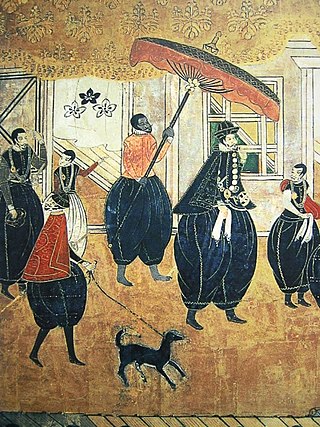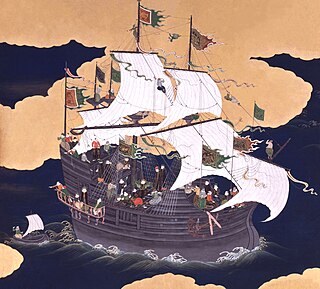Luis de Almeida | |
|---|---|
 Bronze statue in front of the Almeida Memorial Hospital in Ōita | |
| Born | c. 1525 |
| Died | 1597 |
| Nationality | Portuguese |
| Occupation(s) | Surgeon, Merchant and then Missionary of the Society of Jesus |
Luis de Almeida | |
|---|---|
 Bronze statue in front of the Almeida Memorial Hospital in Ōita | |
| Born | c. 1525 |
| Died | 1597 |
| Nationality | Portuguese |
| Occupation(s) | Surgeon, Merchant and then Missionary of the Society of Jesus |
Luis de Almeida was born in 1525 in Lisbon in a New Christian family that had converted from Judaism to Christianity. [1] [2] After two years of training at the prestigious Hospital Real de Todos os Santos, [3] he received surgical license in March 1546 by the Portuguese king. Afterwards he moved to Goa and from there to Macau and became involved in intra-Asian trade with some success. These activities brought him for the first time to Japan in 1552, where the era of direct and sustained Euro-Japanese contacts had begun with the Nanban trade, attracting Portuguese merchants who fulfilled the Japanese demand for silk, cotton, Chinese medicines and other goods that Japan could not produce in sufficient quantities. During his voyage to Asia he was deeply moved by the Jesuit missionaries who tended to the passengers' spiritual needs. Upon reaching Japan, he resolved to travel to Yamaguchi to meet the Jesuit father Cosme de Torres, who was in charge of the mission after Francis Xavier's departure, and from there the two kept in close contact. [1]
In 1555, during his second visit to Japan, he joined the Society of Jesus and was now looking for ways to make good use of his accumulated financial resources. His personal wealth and his continued involvement in the Sino-Japanese silk trade kept the Jesuits financially afloat and provided the funds for various charitable efforts in Japan. For example, in the year of his accession he founded an orphanage in Funai (today Ōita) in the east of the island of Kyushu, because many children had lost their parents due to the fierce hegemonic struggles of the Sengoku period. However, because Almeida's commercial activities, the Jesuits in Japan attracted criticism from Rome for dabbling in trade. [4]
In 1556 he built a hospital in Funai with the permission of the daimyō Ōtomo Sōrin. The construction costs (about 5000 cruzados) were covered from his fortune. As far as the letters sent to Goa and Europe show, this hospital was able to accommodate about 100 patients. Initially, Almeida was in charge of the surgical department, and internal medicine was in the hands of converted Japanese doctors, who were so successful in applying Chinese-Japanese therapies that some of them were singled out by name. [5]
After 1560, Almeida had to give up leading the hospital since an order had arrived in Japan forbidding members of the Society from providing medical practices. [2] From that time on he became an accountant for the Jesuits, and spent 1561 proselytizing in Hakata (now part of the city of Fukuoka), Hirado, and Kagoshima. In 1562 he obtained the landing permit for Portuguese ships in Yokoseura, which briefly thrived as a Portuguese port before it was destroyed the next year by rival merchants. The following year he founded churches in Shimabara and Kuchinotsu. In 1565 he spent his time in the Kansai area, leaving descriptions of a Japanese tea ceremony he witnessed in Sakai and of the magnificent temples of Nara. [1] He did not fully abandon medicine, as he still helped in the Funai hospital, cared for other Jesuit fathers, and administered medicine for Japanese damiyō on occasion. [1]
After years of tireless efforts in the Japanese mission, Almeida was ordained a priest in Macau in 1580. Upon returning to Japan, he was made Superior of Amakusa, which had become Christianized through his efforts. [1] He died three years later in Kawachiura (河内浦; now part of Amakusa). The hospital he built in Funai was destroyed in 1587 by troops from Satsuma. [6]

Luís Fróis was a Portuguese missionary who worked in Asia during the second half of the 16th century.

The State of India, also referred as the Portuguese State of India or simply Portuguese India, was a state of the Portuguese Empire founded six years after the discovery of a sea route to the Indian subcontinent by Vasco da Gama, a subject of the Kingdom of Portugal. The capital of Portuguese India served as the governing centre of a string of military forts and trading posts scattered all over the Indian Ocean.

The history of Goa dates back to prehistoric times, though the present-day state of Goa was only established as recently as 1987. In spite of being India's smallest state by area, Goa's history is both long and diverse. It shares a lot of similarities with Indian history, especially with regard to colonial influences and a multi-cultural aesthetic.

Alessandro Valignano, S.J., sometimes Valignani, was an Italian Jesuit priest and missionary born in Chieti, part of the Kingdom of Naples, who helped supervise the introduction of Catholicism to the Far East, and especially to Japan and China.

The Japanese term Kirishitan, from Portuguese cristão, meaning "Christian", referred to Catholic Christians in Japanese and is used in Japanese texts as a historiographic term for Catholics in Japan in the 16th and 17th centuries.
Gaspar Coelho was a Portuguese Jesuit missionary. He replaced Francisco Cabral as the Superior and Vice-Provincial of the Jesuit mission in Japan during the late 16th century. He catalyzed the disfavor of Toyotomi Hideyoshi against the Jesuit mission in Japan in 1587.
Missionary work of the Catholic Church has often been undertaken outside the geographically defined parishes and dioceses by religious orders who have people and material resources to spare, and some of which specialized in missions. Eventually, parishes and dioceses would be organized worldwide, often after an intermediate phase as an apostolic prefecture or apostolic vicariate. Catholic mission has predominantly been carried out by the Latin Church in practice.

Belchior Carneiro Leitão, SJ, often known as Melchior Carneiro was a Portuguese Jesuit missionary bishop. He was one of the first Jesuit bishops.
Christian missionaries arrived with Francis Xavier and the Jesuits in the 1540s and briefly flourished, with over 100,000 converts, including many daimyōs in Kyushu. It soon met resistance from the highest office holders of Japan. Emperor Ōgimachi issued edicts to ban Catholicism in 1565 and 1568, but to little effect. Beginning in 1587, with imperial regent Toyotomi Hideyoshi's ban on Jesuit missionaries, Christianity was repressed as a threat to national unity. After the Tokugawa shogunate banned Christianity in 1620 it ceased to exist publicly. Many Catholics went underground, becoming hidden Christians, while others died. Only after the Meiji Restoration was Christianity re-established in Japan.

Minchee, or minchi, is a Macanese dish based on minced or ground meat stir-fried with vegetables and seasoned. It is widely considered Macau's national dish.

St. Paul's College of Macau also known as College of Madre de Deus was a university founded in 1594 in Macau by Jesuits at the service of the Portuguese under the Padroado treaty. It claims the title of the first Western university in East Asia.

St. Paul's College was a Jesuit school, and later college, founded circa 1542 by saint Francis Xavier, at Old Goa. It was once the main Jesuit institution in the whole of Asia. It housed the first printing press in India, having published the first books in 1556. The original building, however, was abandoned progressively after the outbreak of plague in 1578, and went into disuse as the college moved to new building known as the New College of Saint Paul. It is an ASI protected Monument of National Importance in Goa.

Nanban trade or the Nanban trade period was a period in the history of Japan from the arrival of Europeans in 1543 to the first Sakoku Seclusion Edicts of isolationism in 1614. Nanban is a Japanese word which had been used to designate people from Southern China, the Ryukyu islands, the Indian Ocean and Southeast Asia centuries prior to the arrival of the first Europeans. For instance, according to the Nihon Kiryaku (日本紀略), Dazaifu, the administrative center of Kyūshū, reported that the Nanban pirates, who were identified as Amami islanders by the Shōyūki, pillaged a wide area of Kyūshū in 997. In response, Dazaifu ordered Kikaijima (貴駕島) to arrest the Nanban.

Macau was a Portuguese colony from the establishment of the first official Portuguese settlement of Macau in 1557 to its handover to China in 1999. It comprised the Municipality of Macau and the Municipality of Ilhas. Macau was both the first and last European holding in China.

Japanese–Portugal relations are the current and historical diplomatic, cultural and trade relations between Japan and Portugal. The history of relations between the two nations goes back to the mid 16th century, when Portuguese sailors first arrived in Japan in 1543, and diplomatic relations officially restarted in the 19th century with the Treaty of Peace, Amity and Commerce.

The Nossa Senhora da Graça incident (ノサ・セニョーラ・ダ・グラサ号事件), alternatively called the Madre de Deus incident (マードレ・デ・デウス号事件), was a four-day naval battle between a Portuguese carrack and Japanese samurai junks belonging to the Arima clan near the waters of Nagasaki in 1610. The richly laden "great ship of commerce", famed as the "black ship" by the Japanese, sank after its captain André Pessoa set the gunpowder storage on fire as samurai overran the vessel. This desperate and fatal resistance impressed the Japanese, and memories of the event persisted even into the 19th century.

The Portuguese presence in Asia was responsible for what would be the first of many contacts between European countries and the East, starting on May 20, 1498 with the trip led by Vasco da Gama to Calicut, India. Aside from being part of the European colonisation of Southeast Asia in the 16th century, Portugal's goal in the Indian Ocean was to ensure their monopoly in the spice trade, establishing several fortresses and commercial trading posts.

The Battle of Fukuda Bay in 1565 was the first recorded naval battle between Europeans and the Japanese. A flotilla of samurai under the daimyō Matsura Takanobu attacked two Portuguese trade vessels that had shunned Matsura's port in Hirado and had gone instead to trade at Fukuda, a port belonging to the rival Ōmura Sumitada. The engagement was part of a process of trial and error by the Portuguese traders to find a safe harbour for their carracks in Japan that eventually brought them to Nagasaki.

Portuguese Nagasaki and Ecclesiastical Nagasaki refer to the period during which the city of Nagasaki was under foreign administration, between the years of 1580 and 1587. Formally granted to the Jesuits, a representative of the Portuguese Crown was considered the highest authority in the city when present, as per Portuguese rights of Padroado.